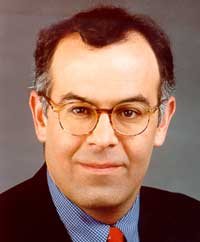
David Brooks (2004): neo-conservative creepy spendthrift fascist
Hey, man, remember 10 years ago, back when David Brooks wrote a column in which he disavowed neo-conservative
as a political label, insisted that there was no coherent group of neo-conservatives,
insisted that the people labeled neocons
had no real influence on the Bush administration and agreed about basically nothing other than foreign policy, and then went on to ridicule everyone who wrote about neocon
influence on the Republican Party and to mock them in the most abusive terms, as full-mooner
, probably anti-Semitic, conspiracy theorists?
In truth, the people labeled neocons (con is short for “conservative” and neo is short for “Jewish”) travel in widely different circles and don't actually have much contact with one another. The ones outside government have almost no contact with President Bush. There have been hundreds of references, for example, to Richard Perle's insidious power over administration policy, but I've been told by senior administration officials that he has had no significant meetings with Bush or Cheney since they assumed office. If he's shaping their decisions, he must be microwaving his ideas into their fillings.
It’s true that both Bush and the people labeled neocons agree that Saddam Hussein represented a unique threat to world peace. But correlation does not mean causation. All evidence suggests that Bush formed his conclusions independently. Besides, if he wanted to follow the neocon line, Bush wouldn’t know where to turn because while the neocons agree on Saddam, they disagree vituperatively on just about everything else. (If you ever read a sentence that starts with Neocons believe,
there is a 99.44 percent chance everything else in that sentence will be untrue.)
–David Brooks (2004), The Era of Distortion
New York Times (January 6, 2004).
Boy howdy, that was a time.

David Brooks (2013): creepy spendthrift fascist neo-conservative
The conservatism that Kristol was referring to is neoconservatism. Neocons came in for a lot of criticism during the Iraq war, but neoconservatism was primarily a domestic policy movement. Conservatism was at its peak when the neocons were dominant and nearly every problem with the Republican Party today could be cured by a neocon revival. . . .
–David Brooks (2013), The Neocon Revival
New York Times (August 1, 2013)
So, in light of a New York Times correction ten years in the making, I will no longer be calling David Brooks a creepy spendthrift fascist.
It’s back to neo-conservative,
which is of course a much more succinct way of saying the same thing.
In case you were wondering, the domestic policy movement
Brooks is so eager to revive, incidentally, is the use of an expansive welfare state for Right-wing social engineering. Or here’s the creepy spendthrift fascist neo-conservative Brooks (2013), in his own words The crucial issue for the health of the nation, in this view, is not the size of government; it is the character of the people. Neocons opposed government programs that undermined personal responsibility and community cohesion, but they supported those programs that reinforced them or which had no effect. Neocons put values at the center of their governing philosophy, but their social policy was neither morally laissez-faire like the libertarians nor explicitly religious like some social conservatives. Neocons mostly sought policies that would encourage self-discipline. In almost every area of public concern, we are seeking to induce persons to act virtuously, whether as schoolchildren, applicants for public assistance, would-be lawbreakers, or voters and public officials,
James Q. Wilson wrote.
You may have noticed that back in 2004, those were exactly the kinds of sentences that David Brooks predicted to have a 99.44% chance of being entirely untrue; since at the time he insisted that the only thing the people labeled neocons
agreed on at all was an aggressive National Greatness foreign policy. But now in 2013 he simply shoves the whole thing to one side within a single sentence, and insists that the main thing they really had in common was their aggressively paternal-statist commitments in domestic policy. I don’t know; I guess maybe something must have happened in the interim so that it is now more politic to talk up neoconservative ideas on domestic policy rather than neoconservative ideas on foreign policy?
Just spitballing here.
Also.


